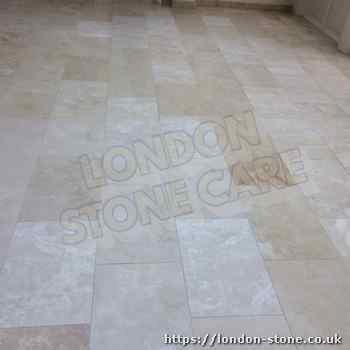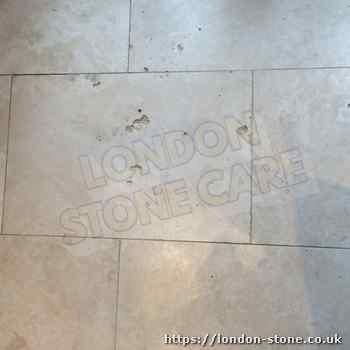
Travertine Cleaning London
Experience Amazing Travertine Cleaning London.
- Your travertine floor cleaning specialists.
- More than two decades working experience cleaning Travertine floors.
- Our trusted industry experts are here to help you with your travertine cleaning, get your quote now.
Travertine Tile Cleaning

Travertine is unusual because it has a structure just like a cinder toffee.
Holes are uncovered by traffic wear, then they fill up with ingrained dirt.
Home-owners cannot clean out this ingrained dirt out from the holes and pits.
In the house, the impacted soil combines with grease and oil.
Just how can we clear away this dirt?

Put on a strong Travertine cleaner onto the floor.
Let the cleaner dwell on the floor for up to 20 minutes.
Use a commercial scrubbing machine to scrub the cleaning solution deep into the Travertine.
Use clean water to rinse off the scrubbing slurry.
repeat the process until the floor is clean.
Honed travertine is typically clean after 1 or 2 scrubbing and rinsing steps.
But, with tumbled Travertine, unfilled or grout filled, the cleaning may need several applications..
After scrubbing and rinsing, deep holes will continue to have dirt.
Pressure Rinsing The Travertine When We Finish Cleaning

The final stage in cleaning Travertine tiles, is known as hot rinse and extraction.
Clean water is pressure sprayed in to the Travertine at pressure, bringing out impacted soil.
Pressure rinsing removes any leftover ingrained soil.
Travertine Sealing
Determining the sub-floor should determine the sort of sealer to apply.
![Travertine sealing work London sealing a Traverttine floor using a Travertine Impergnating sealer [xfield_location]](/wp-content/uploads/Travertine-Cleaning-Restoration-Work-After-1.jpg)
When A Floor Does Not Have Any Damp Proof Membrane.
Solid floors in older homes were not usually set over a damp-proof membrane Layer. using well over four million residential properties in the United Kingdom built in Victorian and Edwardian periods alone, it is a common occurance. These types of floors ought to be sealed using a breathable sealer.
An impregnating sealer is preferred for these kinds of floors.
In the majority of installations three or four layers of impregnating sealer will be enough to stop spills penetrating into the Travertine.
1 layer of impregnating sealer is not enough to shield these types of floors.

Floors With A damp Proof Membrane Film.
In older homes, stone floors were installed lacking a damp-proof film. The UK has a considerable amount of these older buildings using stone basement floors. The floor tiles require permit the movement of moisture from the sub-floor, which usually will affect the option of the sealer.
these kinds of floors need to have a penetrating impregnating sealer.
Travertine will require 3 or more layers of impregnating sealer.
When less sealer is put on, the sealer cannot protect the Travertine.
Sealing Honed Travertine Tiles
Honed travertine is have a a smooth matt mid to high sheen surface. Honed travertine is much more porous as compared to the polished variation, but much less porous than Tumbled Travertine. If you want to retain the original finish, impregnating sealers will be practical. just like polished travertine, impregnating sealers will not prevent Acidic etching.
Honed Travertine can also be protected with a surface sealer or film-forming sealer. Surface sealers offer a protective layer on the Travertine. Acids cause less immediate wear to a surface sealer, but if left, they will eventually penetrate the sealer and wear the Travertine. Surface sealers render extra protection for the Travertine and the grout. Pre-sealing with an impregnating sealer is suggested to improve the protection. When the surface sealer starts to wear, the impregnating sealer still delivers protection until the floor is re-sealed.
You should expect a surface sealer to last two to four years.
Ideally, check wear every six months.
Deep clean traffic areas for them to be re-sealed.
Top the region up with a couple of coats of sealer.
If you will do this, your sealer will work for much longer.
{Also, you may not get an ugly build-up of sealer in the areas that have minimum wear.
Travertine Restoration
Cleaning and repairing travertine is called travertine restoration.
Contact Us Now!
It's simple to book a quotation for your Travertine Cleaning London.Travertine Crack Repair
![Travertine-crack repair - Can you steam clean travertine floors Travertine crack repair [xfield_location] - Can you lay travertine without grout lines](/wp-content/uploads/Travertine-Crack-Repair-Work-1.jpg)
As Travertine features a lattice structure, is likely to exhibit cracks and holes. This means travertine cannot endure as much movement as tougher tiles like Porcelaing, parble and Granite.
Sub floor movement generally causes cracks or fractures in Travertine tiles. Cracks can appear anywhere on a floor, however they are commonly noticeable in doorways. When there's a weakness in a tile, a crack may appear. A crack repair will be noticeable, but a repair is less than the cost of replacement.
Hairline cracks in Travertine are too fine to accept a filling material. Diamond cutters can widen the crack to accept a filling material. A coloured resin or grout filling material enables you to fill the crack. Whenever the resin is hard, we sand it smooth. Grout could be left sponged or dry sanded. However a dirty crack is unsightly in comparison to a repair.
Travertine Hole Repair
![Travertine hole repair -Does travertine get slippery when wet Travertine hole repair [xfield_location] - How much does it cost to seal travertine floors](/wp-content/uploads/Travertine-Hole-Filling-Repair-1.jpg)
cavities will always come in Travertine. Holes come about as Travertine is made like a hard sponge. A Travertine tile will have lots of different size holes. Factory filled Travertine is filled up with a product labeled as Spackle. Spackle isn't as hard-wearing as an epoxy fillers. During the restoration, cavities can be filled up with a grout or resin filler. Resin fillers are very hard and should be sanded smooth after they cure. Resin filling is a costly process due to the price of the fillers therefore the time involved.
Grout-filling holes is a common choice with homeowners. Grout costs notably significantly less than resin fillers and will take a lot less time for you to complete. The gout is put on individual tiles. A grout sponge is employed to remove excess filler. The process leaves the grout slightly below the surface of the tiles.
Travertine Grout Repair
![Travertine grout repair [xfield_location] Travertine grout repair London - Travertine grout repair work](/wp-content/uploads/Travertine-Grout-Repair-Filling-1.jpg)
Typically Travertine tile grout gets stained from spills, or loses its finish from extreme cleaning and harm from powerful cleaning chemicals.
If you have got quite deep grout, it may be regrouted with a new, stable grout.
If the damaged grout isn't very deep, could be taken out with diamond cutting tools and then re-grouted.
The removal of existing grout and re-grouting is a costly job.
Travertine Shower Cleaning
Working on Travertine shower areas is specialist work. Shower areas offer specific issues for Travertine.
Hot water etches Travertine because it is acidic. The hot water etches the Travertine, so a dull white film builds on the surface of the Travertine tiles.
The majority of liquid soaps and cleaning chemicals include acid chemicals. Calcium stones like Travertine and Marble are etched by these products. When we take a shower, soap and the body oils are sprayed onto the Travertine. While the Travertine is being etched, body oils accumulate in the grout lines.
It is tough to stop mould growth in showers. Mould can advance deep into the surface of Travertine, becoming close to impossible to remove. Impregnating sealers can slow the growth of mould, but because they leave the surface open, mould can certainly still develop in the Travertine.
A lot of popular cleaning products for showers incorporate acid. Therefore you should check the ingredients of every cleaning product you will used in a Travertine shower to make sure it does not include any acidic ingredients. Don't risk harming the Travertine by using the wrong shower cleaner.
Steps For Cleaning Travertine Showers
Put on an acid free Travertine cleaning product. A good scrub will get rid of soap and oil residues. When you finish scrubbing, we rinse the Travertine and inspect for further damage.
Etch harm can be removed with diamond honing the Travertine. Professional sealers can coat the tiles, masking the damage.
Replace any mould discolored grout. Once mould gets into a natural stone tile, it is usually permanent.
Mouldy silicon sealants ought to be changed during restoration.
After cleaning and restoration, seal the Travertine with specialist acid-resistant sealers. Sealers are available in a matt, sheen and gloss finish. Though, these sealers are not going to change the finish on the stone. Acid-resistant sealers save time and cash.
Shower areas with Travertine can now last considerably longer, before they require restoring.
Contact Us Now!
Get your free stone floor cleaning London quotation today.Use of Travertine In London
While popular London tourist attractions are worth a visit, including the Tower of London and the London Eye. London is also the home to innovative uses of Travertine.
Some examples of Travertine in London
- 40 Chancery Lane. Prestigious office complex clad in Travertine
- The Adelphi on the north bank of the river Thames has impressive travertine interiors.
- A superb sculpted travertine wall inside the 20 Gresham Street building in London